LOS ALAMOS & SANTA FE (Day 3 - part 3)
Manhattan Project National Historical Park is one of the nation's newest national parks. Established in November 2015, it preserves portions of the World War II-era sites where the US developed the first atomic weapons. It's unique in that it is not just in one spot... but rather in three. While more than 30 separate sites were part of the project, these were the three key ones:
- where they designed the bomb: Project Y, the various buildings spread around Los Alamos,
with 17 at the lab and 13 in the downtown area (not all are accessible to the public and some are privately owned)
- the uranium purification facility: Site X in Oak Ridge, Tennessee
- the plutonium processing facility: Site W in Hanford, Washington

Together, these places tell the story of 600,000 Americans who left their homes and families to work on a mysterious project that was vital to the war effort.


A movie was playing that filled in some more details.

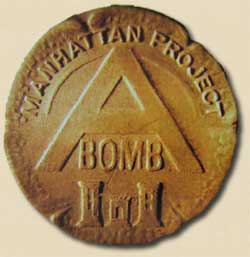
A silver pin was awarded to employees who completed at least 12 months of service. This copper one was given to those who worked at least 6 months. The design underneath the A is of the Army Corp of Engineers (originally based out of Manhattan, New York.)
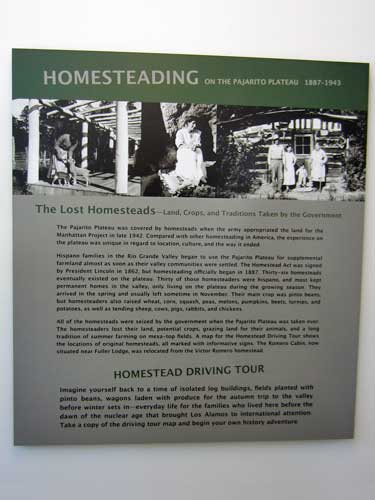
Homesteaders were required to vacate their homes, sometimes with very little notice and scant compensation. Altogether 54,000 acres were acquired for Project Y.

The letter that closed down the Los Alamos Ranch School (Click for a larger version)

In early 1943, approximately 1,000 people lived in Los Alamos. By the end of 1944, there were more than 5,500. The average age was 25.
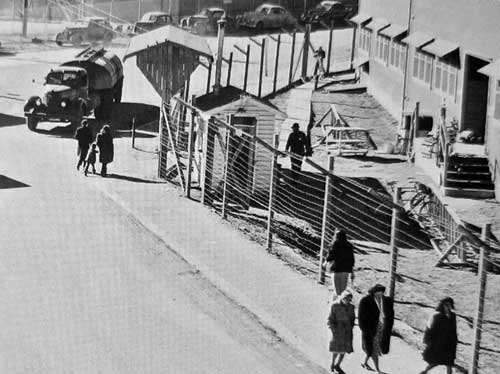

The post was never intended to be permanent, so hastily built dirt roads often turned into muddy trenches during the summer rainy season.

Ashley Pond (circa 1957)... cutely named after Ashley Pond, founder of the Los Alamos Ranch School
While it is most often just a few scientists who get all the fame, it took a lot of people doing the basic tasks and day-to-day work that helped keep the place functional.

More than 1,800 young men were sent here as SED's (Special Engineer Detachment) because of their scientific or technical training.

Telephone operators at the switchboard.

In 1943, more than 80 babies were born in Los Alamos (or in P.O. Box 1663, as their birth certificates showed) After that, about 10 newborns arrived every month.

We then took a brief drive around the downtown, seeing a few of the historic buildings.

A map of some of the closest sites (Click for a larger view)

Ashley Pond today

Oppenheimer and Groves

The Fuller Lodge was built in 1928 as the Ranch School dining hall. Named after Edward P. Fuller, a staff member at the school, it is made of 771 massive pine logs personally selected by the school's director, A.J. Connell. As part of Project Y, it served as a restaurant, shops, and residences for top project administrators. As the only group of buildings in the town that had bathtubs instead of showers, this stretch quickly became known as Bathtub Row.

The Baker House (currently a private residence) was built for the school's chief mechanic. During the Manhattan Project, it housed various high-ranking personnel including Sir James Chadwick of the British Technical Mission and Dr. Richard Baker, a leader in plutonium chemistry. Richard and his wife Bonnie lived here from 1959 to 1995.
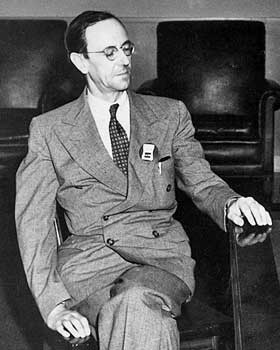
Sir James Chadwick (1891 - 1974) was awarded the 1935 Nobel Prize in Physics for his discovery of the neutron.

In the early 1930's, this building was built to house the school's diesel generators. It later became the residence of George Kisiakowsky, the Lab's explosive expert.
We stopped at a lovely central park which was filled with interesting homesteading history as well as ancestral pueblo ruins.

Human history on the Pajario Plateau goes back at least 10,000 years to the first hunters. Later, the land was farmed by the Pueblo Indians. Spanish explorers arrived in the 1600's, and Hispanic settlers grazed livestock here in the summers. Homesteading began after President Abraham Lincoln signed the Homestead Act in 1862.
The Homestead Acts were federal laws that gave an applicant ownership of land or "homestead" at little or no cost. All totaled, more than 270 million acres of public land (or nearly 10% of the total area of the U.S.) were given away to 1.6 million homesteaders. Immigrants, farmers without their own land, single women and former slaves could all qualify.
The requirements were that a homesteader:
- 1) had to be a citizen (or have filed a declaration of intention to become a citizen
- 2) had to be head of the household or at least 21 years old
- 3) had to live on the designated land, build a home, make improvements, and farm it for a minimum of five years
- 4) had to pay the filing fee of $18
It was a difficult life. The plateau was isolated, rugged and lacked water for irrigation. But the homesteaders practiced dry farming, ranching, and gathered the native edible plants. In the winters due the heavy snow, they retreated to homes in nearby valley settlements. The Homestead Act was amended in 1912 to allow them to absent part of the year.

Children worked the farms in the summer but attended schools in the valley during the winter.
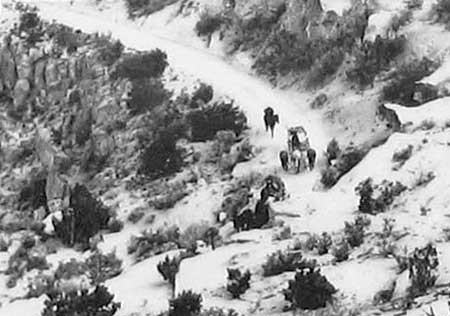
Each season, homesteaders travelled back up to the plateau farms by wagons, bring with them canned goods and other food staples. The Camino de la Culeba (Snake Road) is now the main road to Los Alamos today.

A map of the plateau homesteads, showing some of the 36 claims, including the Romero homestead (Click for a larger view)

Victor Romero built this one-room cabin on his homestead land in 1913 for himself, his wife and their six children. They farmed and raised livestock in the summer and returned to the Rio Grande Valley every winter. Like many other properties, it was acquired by the US Government in 1943. In 1985, it was moved here. It was restored in 2009. It is one of the last examples of its type on the plateau. Most others were destroyed in May 2000 by the Cerro Grande fire.


A 1946 photo of the old homestead cabins
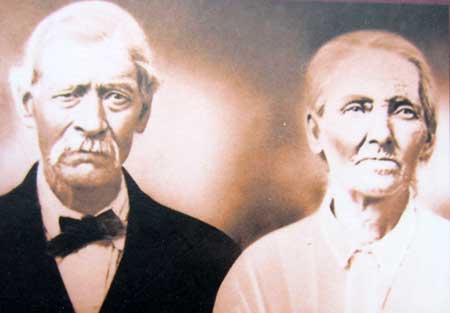
David and Francisquita Romero were Victor's parents... and his neighbors. Extended families often shared in the hard work on the plateau.
The Los Alamos Mesa homesteaders:

Harold H. Brook came from Illinois to Santa Fe for the treatment of tuberculosis. He recovered and applied for land in 1908 and again in 1913. He received both in 1914. He invested heavily in farming equipment but in the end was unsuccessful. In 1917, he became partners with Ashley Pond to start a boys' school... the Los Alamos Ranch School. Eventually he sold his share and moved to Las Cruces where he died from tuberculosis in 1924.

Harold also bought land in the name of his mother, Martha. She was in her 50's and had medical problems, so she didn't like being there and instead chose to remain in her warm home in Las Cruces. Technically this was in violation of the Homestead Act, but because Harold kept the property in good order, the inspection rangers let it slide. He sold her land along with his in 1920.
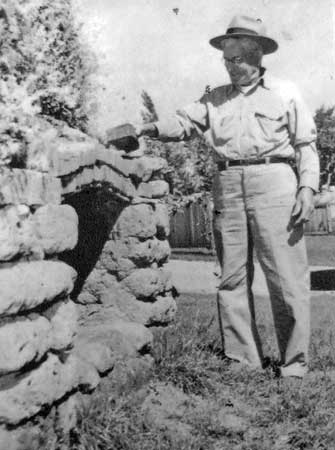
William Mackwood Hopper knew Brook from Santa Fe. He applied at the same time for the adjacent homestead. However, after receiving the land, he changed his mind and immediate sold his holdings to Brook and left New Mexico.

After Ashley Pond bought Brook's ranch, he hired Albert J. Connell to be the director. Much of the surrounding land on the Los Alamos mesa was national forest and therfore not available for homesteading. The school was able to lease the land but not buy it. As a work around, the US Forest Service agreed to trade the land for another parcel of equal value. Unfortunately Connell couldn't afford to buy enough land that the forest service wanted in order to cover the entire 640-acre section, but in 1931, he was at least able to trade 160 acres he had purchased for 40 acres here (which included a part of Ashley Pond). Unfortunately it was all taken from him by the government in 1942. He died the following year, some say of a broken heart.

Around the year 1225, this pueblo was home to a group of Tewa-speaking people. The various rooms were used for cooking, sleeping and storage. They farmed corn, beans and squash, made pottery, wove clothing from cotton, and made sandals from yucca leaves.

A map of the pueblo


Cute decorations embedded in the sidewalk

This was the ranch school's firehouse. It was built using stones scavenged from the pueblo dwelling.
We said goodbye to Los Alamos and headed to the nearby town of White Rock, in quest of the scenic overlook

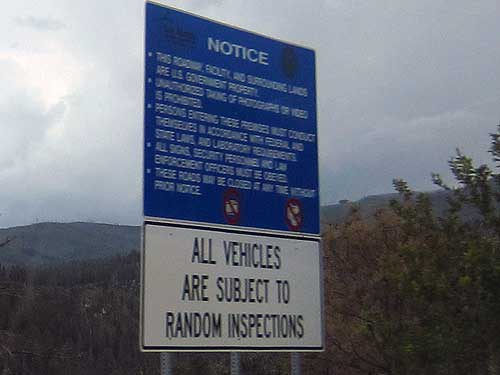
Driving through government propery


return • continue

